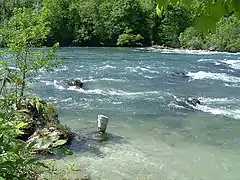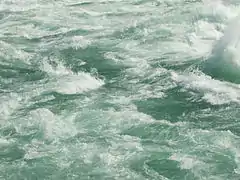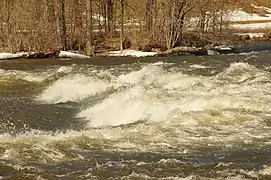Rapids
Rapids are sections of a river where the river bed has a relatively steep gradient, causing an increase in water velocity and turbulence.
Rapids are hydrological features between a run (a smoothly flowing part of a stream) and a cascade. Rapids are characterised by the river becoming shallower with some rocks exposed above the flow surface. As flowing water splashes over and around the rocks, air bubbles become mixed in with it and portions of the surface acquire a white colour, forming what is called "whitewater". Rapids occur where the bed material is highly resistant to the erosive power of the stream in comparison with the bed downstream of the rapids. Very young streams flowing across solid rock may be rapids for much of their length. Rapids cause water aeration of the stream or river, resulting in better water quality.
Rapids are categorized in classes, generally running from I to VI.[1] A Class 5 rapid may be categorized as Class 5.1-5.9. While Class I rapids are easy to navigate and require little maneuvering, Class VI rapids pose threat to life with little or no chance for rescue. River rafting sports are carried out where many rapids are present in the course.
 Rapids featuring whitewater, close to the Rhine Falls
Rapids featuring whitewater, close to the Rhine Falls Violent water below Niagara Falls
Violent water below Niagara Falls Rapids on the Mississippi River (Ontario) in Pakenham, Ontario, Canada.
Rapids on the Mississippi River (Ontario) in Pakenham, Ontario, Canada..jpg.webp) Historical image of the river rapids on the Maumee River in Ohio
Historical image of the river rapids on the Maumee River in Ohio
See also
- Fluid dynamics
- International Scale of River Difficulty - for classification of rapids
- Rheophile - organisms that live in fast flowing water
- Riffle - A fast moving portion of a stream without the vigour of a rapid
References
| Wikimedia Commons has media related to Rapids. |
- Walbridge, Charlie; Singleton, Mark (2005). "International Scale of River Difficulty". American Whitewater. Archived from the original on 2 April 2018. Retrieved 16 June 2018.
- Mason, Bill (1984). Path of the Paddle. Northword Press. ISBN 9781559710046.